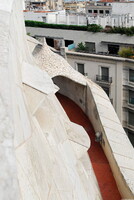Casa Milà
Gaudí, Antoni

Download1A1-GA-CM-G45_cp.jpg (396.2Kb)
Alternative Title
La pedrera
Date
1906-1910Description
Roof terrace, view of walkway at parapet; Going far beyond the exuberant use of natural forms in sculpture and wrought-ironwork, which were the hallmarks of Modernisme (the Catalan term for Art Nouveau), Gaudí turned to nature to generate structural form. The Casa Milà (‘La pedrera’) is one of Gaudí’s most important achievements. In this ambitious corner project, his approach to the creation of a new architectural organism was unencumbered by any existing work, and the curvilinear planning of the floors around magnificent patio spaces was possible from the outset. Again drawing inspiration from nature, Gaudí presented a rock-face of fluid, curvilinear forms to the street; openings appear to be carved out of the stonework in rounded forms with deep overhangs, giving rise to the building’s nickname ‘the quarry’. The tiled roof follows the rise and fall of the superstructure of the attic storey as it spans spaces of varying widths on the floors below. The result is a heaving roofscape, and on this stands a fantastic family of chimneys and ventilators sculpted in twisted, faceted, sometimes quasi-figural shapes. The hand-moulded ceilings in the flats, the wrought-iron balustrades and grilles, completed to Gaudí’s designs by Jujol, and the walls of the patios, painted by Alexis Clapes (1850–1920), are among the delights of Modernisme and contribute to the completeness of Gaudí’s most mature secular work. Source: Grove Art Online; http://www.oxfordartonline.com/ (accessed 7/15/2010)
Type of Work
apartment houseSubject
abstraction, architecture, botanical, decorative arts, Twentieth century, Art Nouveau
Rights
Rights Statement
Licensed for educational and research use by the MIT community only